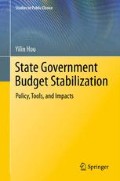Abstract
This chapter examines the effects of boom-year savings on budgetary actions that states often take during a recession. Here I draw the link between countercyclical fiscal policy and the concept of countercyclical fiscal capacity (CCFC). I define CCFC as the accumulation of savings in boom years and the use of them during revenue shortfalls to maintain countercyclical spending and program stability. Because a basic challenge for state governments is to maintain budgetary stability and program predictability in face of economic downturns, states can best meet this challenge by developing the “countercyclical fiscal capacity.” In this chapter, I operationalize CCFC in terms of fiscal reserves (BSF and GFS) and analyze the operation of such reserves over a period that includes recessions in 1991 and 2001. I find evidence of the efficacy of countercyclical fiscal capacity and argue for states to make greater investments in this aspect of governance capacity.
This chapter draws from data and analysis in Hou Y and Moynihan D (2008) The case for counter-cyclical fiscal capacity. J Public Adm Res Theory 18(1):139–159.
Access this chapter
Tax calculation will be finalised at checkout
Purchases are for personal use only
Notes
- 1.
National Council of State Legislatures, http://www.ncsl.org/programs/legman/statevote/statevote2000.htm
- 2.
In this chapter I use the term GFS rather than GFB, see Section 3.2 for the rationale. GFB figures in the i often include BSF balances. Not excluding BSF from these GFB figures will cause double counting. Specifically, California’s BSF balance is reported to be negative in 1991 (−1,715 millions) and 2002 (−3,535 millions), both much larger than the negative balance of the GFB. In such cases, we turn the BSF into zeros and these larger negative balances to be the revised GFB. For more information, see California Code 16418 (d).
- 3.
The annual balances of BSF and the annual GFS may be serially correlated, even after they are converted into per capita real levels. The Prais-Winsten (1954) model is chosen to correct for the serial correlation.
- 4.
One caveat to keep in mind with this model is that it does not include state-specific recessions, and so changes in the dependent variables, while dependent on cyclical fluctuations, may also arise from other factors.
References
Allan IJ (1990) Unreserved fund balance and local government finance. Research Bulletin of the Government Finance Officers Association (GFOA), Chicago
Berry WD, Ringquist EJ, Fording RC, Hanson RL (1998) Measuring citizen and government ideology in the American states 1960–93. Am J Polit Sci 42(1):327–348
Douglas JW, Gaddie RK (2002) State rainy day funds and fiscal crises: rainy day funds and the 1990–1991 recession revisited. Public Budg Finance 22(1):19–30
Hou Y (2003b) What stabilizes state general fund spending during downturns: budget stabilization fund, general fund unreserved undesignated balance, or both? Public Budg Finance 23(3):64–91
Hou Y (2004) Budget stabilization fund: structural features of the enabling legislation and balance level. Public Budg Finance 24(3):38–64
Hou Y, Smith DL (2006) A framework for understanding state balanced budget requirement systems: re-examining distinctive features and an operational definition. Public Budg Finance 26(3):22–45
Hou Y, Moynihan DP, Ingraham PW (2003) Capacity, management and performance: exploring the links. Am Rev Public Adm 33(3):295–315
Johnson N (2002) The state tax cuts of the 1990s, the current revenue crisis, and the implications for state services. Center on Budget and Policy Priorities, Washington, DC
Joyce PG (2001) What’s so magical about five percent? A nationwide look at factors that influence the optimal size of state rainy day funds. Public Budg Finance 21(2):62–87
Knight B, Levinson A (1999) Rainy day funds and state government savings. Natl Tax J LII(3):459–472
Lauth TP (2003) Budgeting during a recession phase of the business cycle: the Georgia experience. Public Budg Finance 23(2):26–38
Mullins DR, Wallin BA (2004) Tax and expenditure limitations: introduction and overview. Public Budg Finance 24(4):2–15
O’Toole LJ, Meier KJ (1999) Modeling the impact of public management: implications of structural context. J Public Adm Res Theory 9(4):505–526
Pollock R, Suyderhoud JP (1986) The role of rainy day funds in achieving fiscal stability. Natl Tax J 43(4):485–497
Posner P, Gordon BS (2001) Can democratic governments save? Experience of countries with budget surpluses. Public Bud Finance 21(2):1–28
Poterba J (1994) State responses to fiscal crisis: the effects of budgetary institutions and politics. J Polit Econ 102(4):799–821
Prais SJ, Winsten CB (1954) Trend estimators and serial correlation. Cowles Commission discussion paper no. 383, Chicago
Provan KG, Milward HB (1995) A preliminary theory of interorganizational network effectiveness: a comparative study of four community mental health systems. Adm Sci Q 40(1):1–33
Sobel RS, Holcombe RG (1996) The impact of state rainy day funds in easing state fiscal crises during the 1990–1991 recession. Public Budg Finance 16(4):28–48
Wagner G, Elder E (2005) The role of budget stabilization funds in smoothing government expenditures over the business cycle. Public Finance Rev 33(1):439–446
Author information
Authors and Affiliations
Appendix
Appendix
Rights and permissions
Copyright information
© 2013 Springer Science+Business Media, LLC
About this chapter
Cite this chapter
Hou, Y. (2013). Effects of Boom-Year Savings on Bust-Year Budgetary Actions. In: State Government Budget Stabilization. Studies in Public Choice, vol 8. Springer, New York, NY. https://doi.org/10.1007/978-1-4614-6061-9_7
Download citation
DOI: https://doi.org/10.1007/978-1-4614-6061-9_7
Published:
Publisher Name: Springer, New York, NY
Print ISBN: 978-1-4614-6060-2
Online ISBN: 978-1-4614-6061-9
eBook Packages: Business and EconomicsEconomics and Finance (R0)

